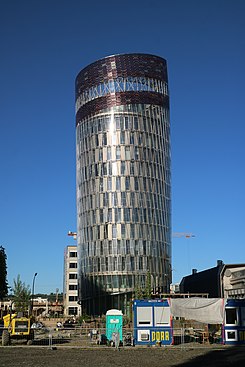Science Tower (Graz)
| Science Tower | |
|---|---|

|
|
| Science Tower from the West (May 2020) | |
| Basic data | |
| Place: | Graz |
| Construction time : | 2015-2017 |
| Opening: | September 21, 2017 |
| Status : | Built |
| Architectural style : | Modern |
| Architect : | Markus Pernthaler |
| Use / legal | |
| Usage : | Office space and seminar rooms, urban gardening |
| Owner : | Science Tower GmbH |
| Client : | SFL Technologies |
| Technical specifications | |
| Height : | 60 m |
| Top floor: | 45 m |
| Floors : | 13 |
| Elevators : | 1 |
| Floor area : | > 2700 m² |
| Building material : | Metal, wood, glass |
| Building-costs: | 16 million euros |
| address | |
| Address: | Waagner-Biro-Strasse 100 |
| Post Code: | 8020 |
| City: | Graz |
The Science Tower is a high-rise building in the capital Graz in the Austrian state of Styria . It forms the heart of the smart city that is being developed near the main train station . The office building, described as a new urban landmark, has a large energy glass facade , the core technology of which is the so-called Grätzel cell .
Building history
The first smart city district of Graz is being built under the name My Smart City Graz, partly on the site of the former Waagner-Biro -Werke in the Lend district to the northwest of the main train station. The groundbreaking for the Science Tower immediately north of the Helmut-List-Halle took place on May 5, 2015 under the contractor SFL Technologies . The architectural office Markus Pernthaler could be engaged for the creative implementation . In June 2016, found out ceremony held on 21 September 2017, the skyscraper was attended by Infrastructure Minister Jörg Leichtfried opened. Based on the modern energy glass facade, the politician called the building a “lighthouse in the truest sense of the word”. The construction costs amounted to 16 million euros , a good quarter of which was funded by the Climate and Energy Fund in cooperation with the Federal Ministry for Transport, Innovation and Technology .
description
The building is composed of a double-shell facade , which encases the basic shape of a truncated cone standing on its tip . The inner facade consists of metal up to the third floor , above it of larch wood . The outer shell consists partly of energy glass, which can generate, store and release energy as required. In this way, both the building tenants and all the electric vehicles in the new district can be supplied with electricity. The core component is the Grätzel cell ( dye-sensitized solar cell , DSC), which can convert sunlight into electricity without using silicon . This process takes place with the help of an organic dye and is therefore sometimes described as "artificial photosynthesis ". The energy glass, refined in the form of laminated safety glass, consists of two coated glass panes lying next to one another, the space between which is filled with a colored electrolyte . This makes the glass appear transparent in color and can be used on both sides. The windows embedded in the larch wood facade can be closed with perforated wooden doors and thus serve as sun and heat protection. In addition, there is a mobile sun protection with integrated ultra-light photovoltaic modules .
The building is heated and cooled by a geothermal system consisting of twelve geothermal probes , each 200 meters deep . In summer, a bypass circuit enables air conditioning without the aid of heat pumps ("free cooling").
use
Up to the twelfth floor (45 meters high), the Science Tower accommodates office space for various companies that deal with environmental technology issues. The tenants include the Styrian research facility Joanneum Research , the Graz University of Technology and the Graz branch of the European Space Agency (ESA). The resident institutions form a scientific cluster with surrounding companies and universities. The high-rise itself also serves as a real laboratory in the field of new building technologies due to its extensive energy self- sufficiency .
In October 2017, Austria's 30-year membership in the ESA was celebrated in the Science Tower. In April 2018, the building opened its doors to the public for the first time as part of the Long Night of Research , and in November of the same year a press conference with ESA Director General Johann-Dietrich Wörner took place on the occasion of the Austrian EU Council Presidency . In April 2019, a roof garden of 300 m², looked after by Joanneum Research, was opened.
Web links
Individual evidence
- ↑ a b c The Science Tower. Science Towe GmbH, accessed on July 11, 2020 .
- ↑ a b Lighthouse of an intelligent city: “Science Tower Graz” has opened. APA - OTS , September 22, 2017, accessed July 11, 2020 .
- ↑ a b Projects - The Science Tower. Graz - UNESCO City of Design, accessed on July 11, 2020 .
- ↑ Energy glass facade. Science Tower GmbH, accessed on July 11, 2020 .
- ↑ The Science Tower. Smart City Graz, accessed on July 11, 2020 .
- ↑ geothermal energy buffer. Science Tower GmbH, accessed on July 11, 2020 .
- ^ "SFL Science Tower" opened in Graz. ORF , September 21, 2017, accessed on July 11, 2020 .
Coordinates: 47 ° 4 ′ 48 ″ N , 15 ° 24 ′ 40 ″ E
